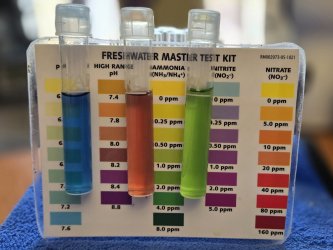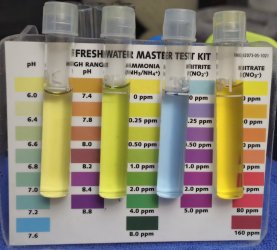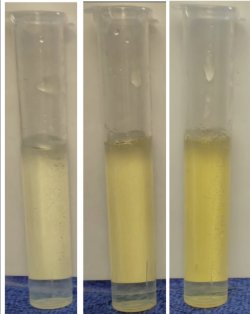TwoTankAmin
Fish Connoisseur
Based on your Ammonia calc numbers you should have done nothing. The level of toxic ammonia in the tank is so low as not to matter at all. Changing water will just slow down the recovery of the bacteria. I disagree 100% withColin in this point. You do not automatically need to change water at any level of ammonia or nitrite.
The progress of any cycle as well as the ultimate amount of bacteria that will be created in a tank is a function of one thing- ammonia levels. The bacteria only reproduce when there is mopre ammonia than they need to thrive. When this is the case they divide. If the concentration of ammonia in a tank changes, so will the reproductive rate of the bacteria. This works in both directions. if you add more fish or other things that increase ammonia levels, the bacteria will reproduce faster than they naturally would and their numbers increase.
Conversely, if the ammonia load in a tank is decreased, reproduction slows to below the stable rate and the amount of bacteria decreases. You can likely let your tank run at the above parameters for some time. At 6.0 the danger is from the ammonium not the ammonia. So, you can likely run for a few weeks at the parameters you report and not harm the fish.
Where I have a problem with the number you report is why the water is at 6.0. The KH is what holds up the pH. Please go here and read about water chemistry and altering it: https://fins.actwin.com/mirror/begin-chem.html
How do you test the kH? Many kits do this in degrees not ppm. Typically there are 17.8 ppm in a degree of either GH or KH. If your number of 71.6 would be about 4 degrees. This should be enough to keep the pH higher than 6.0.
I do not agree at all with what Colin wrote above. Do not change water at any reading of ammonia, use the Calculator and do nothing until the NH3 goes over .05 ppm. If the Total Ammonia is at 2.0 or higher, then do a water change if the NH3 is well over .05. For nitrite you do not need tpo do a water change ever because a bit of salt blocks nitrite from entering a fish. Directions for using salt to block nitrite can be found here: https://www.fishforums.net/threads/rescuing-a-fish-in-cycle-gone-wild-part-il.433778/
The use of the minimal amount of salt needed to counteract nitrite is not enough to have any effect on the cycle at all. It wont bother most fish either because the salt level is low. The time it needs to be in the water is not very long- just until the nitrite drops to 0. Unfortunately, there is no equivalent to the chloride in salt blocking nitrite for use with ammonia. There, the important consideration is to avoid changing water or turning the ammonia into ammonium unless the ammonia (NH3) component exceeds .05 ppm. But using an ammonia detoxifier will slow the cycle.
The reason for avoiding water changes is they slow the cycle. By reducing the ammonia level one also reduces the amount of bacteria that will be created. What makes the fishless cycle so inviting (aside for no fish being harmed) is we usually do not need to change water unless we have added too much ammonia. That is why the article here suggest using 3 ppm on the Total Ion scale. For Doctor Tim, who uses the Nitrogen scale, that number is 2.56 ppm. He advises not exceeding 5 ppm for Ammonia-N or Nitrite-N. On the Total Ion scale those numbers would be 6.25 ppm for ammonia and 16.27 ppm for nitrite. The API kit measures using the Total Ion scale.
The progress of any cycle as well as the ultimate amount of bacteria that will be created in a tank is a function of one thing- ammonia levels. The bacteria only reproduce when there is mopre ammonia than they need to thrive. When this is the case they divide. If the concentration of ammonia in a tank changes, so will the reproductive rate of the bacteria. This works in both directions. if you add more fish or other things that increase ammonia levels, the bacteria will reproduce faster than they naturally would and their numbers increase.
Conversely, if the ammonia load in a tank is decreased, reproduction slows to below the stable rate and the amount of bacteria decreases. You can likely let your tank run at the above parameters for some time. At 6.0 the danger is from the ammonium not the ammonia. So, you can likely run for a few weeks at the parameters you report and not harm the fish.
Where I have a problem with the number you report is why the water is at 6.0. The KH is what holds up the pH. Please go here and read about water chemistry and altering it: https://fins.actwin.com/mirror/begin-chem.html
How do you test the kH? Many kits do this in degrees not ppm. Typically there are 17.8 ppm in a degree of either GH or KH. If your number of 71.6 would be about 4 degrees. This should be enough to keep the pH higher than 6.0.
I do not agree at all with what Colin wrote above. Do not change water at any reading of ammonia, use the Calculator and do nothing until the NH3 goes over .05 ppm. If the Total Ammonia is at 2.0 or higher, then do a water change if the NH3 is well over .05. For nitrite you do not need tpo do a water change ever because a bit of salt blocks nitrite from entering a fish. Directions for using salt to block nitrite can be found here: https://www.fishforums.net/threads/rescuing-a-fish-in-cycle-gone-wild-part-il.433778/
The use of the minimal amount of salt needed to counteract nitrite is not enough to have any effect on the cycle at all. It wont bother most fish either because the salt level is low. The time it needs to be in the water is not very long- just until the nitrite drops to 0. Unfortunately, there is no equivalent to the chloride in salt blocking nitrite for use with ammonia. There, the important consideration is to avoid changing water or turning the ammonia into ammonium unless the ammonia (NH3) component exceeds .05 ppm. But using an ammonia detoxifier will slow the cycle.
The reason for avoiding water changes is they slow the cycle. By reducing the ammonia level one also reduces the amount of bacteria that will be created. What makes the fishless cycle so inviting (aside for no fish being harmed) is we usually do not need to change water unless we have added too much ammonia. That is why the article here suggest using 3 ppm on the Total Ion scale. For Doctor Tim, who uses the Nitrogen scale, that number is 2.56 ppm. He advises not exceeding 5 ppm for Ammonia-N or Nitrite-N. On the Total Ion scale those numbers would be 6.25 ppm for ammonia and 16.27 ppm for nitrite. The API kit measures using the Total Ion scale.




 bottled water only over here.
bottled water only over here. 




 My poor babies are not happy. This morning ALL of them were active swimming around in CONSTANT search of a snack
My poor babies are not happy. This morning ALL of them were active swimming around in CONSTANT search of a snack